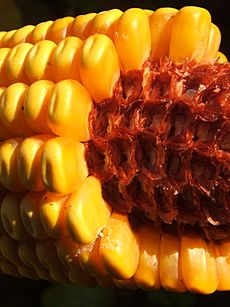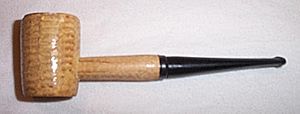Corncob facts for kids

A corncob, also called cob of corn or corn on the cob, is the central core of an ear of corn (also known as maize). It is the part of the ear on which the kernels grow. The ear is also considered a "cob" or "pole" but it is not fully a "pole" until the ear is shucked, or removed from the plant material around the ear.
Young ears, also called baby corn, can be consumed raw, but as the plant matures the cob becomes tougher until only the kernels are edible.
When harvesting corn, the corncob may be collected as part of the ear (necessary for corn on the cob), or instead may be left as part of the corn stover in the field.
The innermost part of the cob is white and has a consistency similar to foam plastic.
Uses
Corncobs find use in the following applications:
- Industrial source of the chemical furfural
- Fiber in fodder for ruminant livestock (despite low nutritional value)
Other applications include:
- Bedding for animals – cobs absorb moisture and provide a compliant surface
- Ground up and washed (then re-dried) to make cat litter
- A mild abrasive for cleaning building surfaces, when coarsely ground
- Raw material for bowls of corncob pipes
- As a biofuel
- Charcoal production
- Environmentally-friendly rodenticide (powdered corn cob)
- Soil conditioner, water retainer in horticulture
- Absorbent media for safe disposal of liquid and solid effluents
- Diluent/carrier/filler material in animal health products, agro-chemicals, veterinary formulations, vitamin premixes, pharmaceuticals, etc.
- Xylose – a sweetener
See also
 In Spanish: Raquis de maíz para niños
In Spanish: Raquis de maíz para niños


